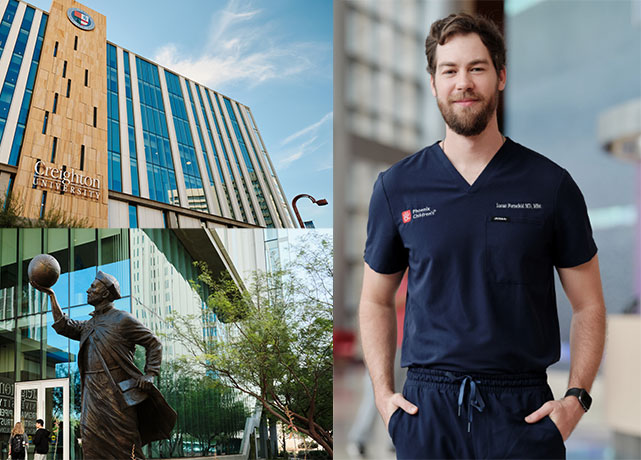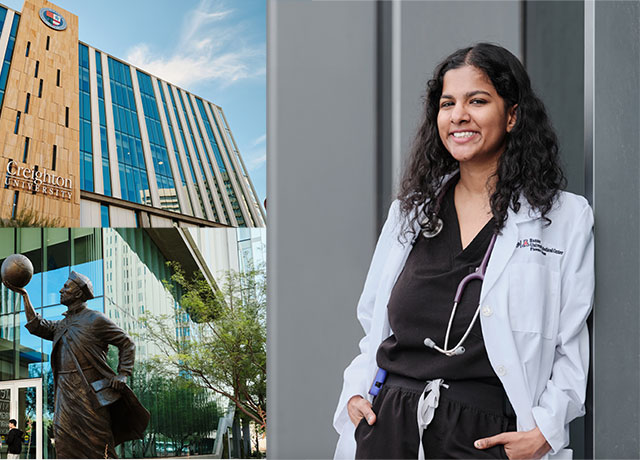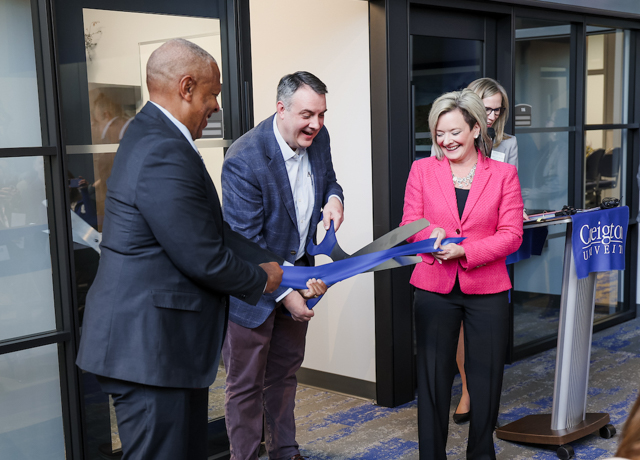Featured Testimonial About Creighton University
The philosophy is just different. It teaches not just … ‘find the problem, treat the problem.’ Creighton teaches you to understand the problems that could occur, find them, fix them and then set the patient up for the best case in the long run.
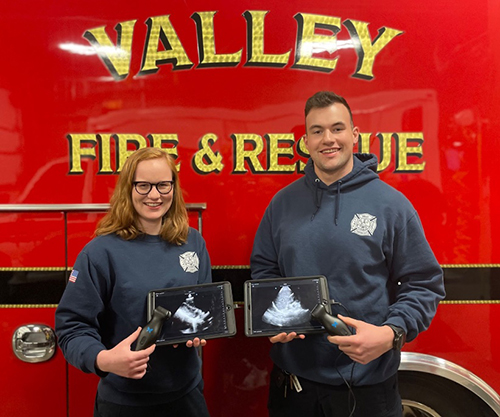
By Micah Mertes
Two things you might not know about the Valley Fire Department, the 100% volunteer organization providing fire protection, rescue and emergency medical services across 45 square miles to the citizens of Valley, Nebraska, and western Douglas County …
1. A good deal of the department’s medics and EMTs are also alumni, students and/or adjunct instructors of Creighton’s Paramedicine program, or are at least in some way affiliated with it.
2. The Valley Fire Department’s medics are spearheading a piece of cutting-edge tech, making them one of the first volunteer emergency services in the nation to implement it into its rescue squads.
First, let’s talk tech. It’s called the Point of Care Ultrasound (POCUS). The POCUS is the same kind of ultrasound used in hospitals but smaller, portable. It’s a handheld probe that can be used during the ambulance ride to scan the patient for a number of reasons — IV insertion, identifying internal bleeding or fetal heartbeats, looking at the patient’s heart while CPR is in progress.
By identifying these things on the way to a trauma center or emergency room, the medics are able to get patients the care they need as soon as possible in scenarios where every second counts.

VFD and its more than 40 members purchased the POCUS technology with department funds because they believed the equipment would save lives in the community they serve. The department has two POCUS probes, equipping both of its ambulances with the ultrasound technology.
Valley Rescue Lieutenant Christopher Pritza, BSEMS'22 — also a Creighton paramedicine instructor and current student in the College of Nursing — has already seen the POCUS drastically change outcomes for some of his patients. One in particular stands out.
The patient was in a motorcycle accident, experiencing severe chest and back trauma when he was loaded into the ambulance. The patient was showing signs of a punctured lung (when air in the chest compresses the lung, making it difficult or impossible to breath).
Usually in such cases, medics will insert a needle into the chest to release the trapped air. But since Valley rescue medics now had the POCUS, they could scan to see if it really was a punctured lung. Turns out, it wasn’t. And the paramedics were able to send their scan and convey their findings to the medical center en route, saving precious time for the patient.
“As paramedics,” Pritza says, “when we’re treating our patients, we have to look off of objective things, like skin color, blood pressure, heart rate. We’re usually very limited to the outside of the patient.”

“We had been looking through a keyhole,” says Valley rescue captain Emma Zeratsky, BSEMS'21, (also a Creighton College of Nursing student). “Now, with the POCUS, we get to open the door.”
The origins of the Valley Fire Department becoming one of the first volunteer rescue squads to use this tech started at Creighton. This was in the fall of 2020, when Zeratsky and other mutual members of the paramedicine program and VFD were introduced to the POCUS tech through a class in critical care taught by Rick Erickson, Creighton’s Critical Care Paramedic Coordinator.
Zeratsky: “We came back to the Valley station after class and started talking about how cool ultrasound technology was and wondering if it would be possible to implement it into our care.”
Two years later — following a pilot program and with some help from the Creighton paramedicine department’s former director Mike Miller, BSEMS’07, MS’10, EDD’14 — the Valley ambulances are now equipped with POCUS devices.
So, how exactly did the Creighton to Valley Fire Department pipeline start?
It probably has at least a little to do with one of the fire department’s unique policies. Unlike most local teams, you don’t have to live within the district to serve on the department, making Valley an excellent choice for EMS students living in Omaha who want to join a team that takes about 600 calls a year.
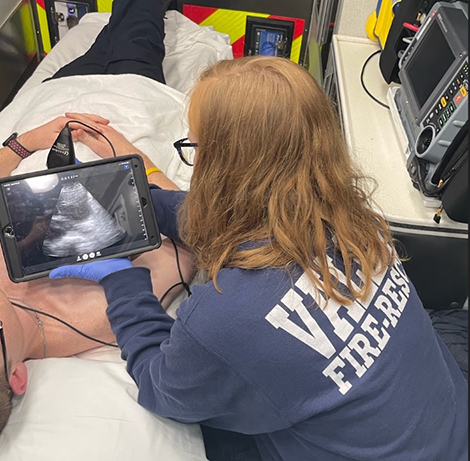
The Creighton-Valley Fire Department connection only snowballed from there, with Creighton graduates recruiting Creighton students who then became Creighton adjunct instructors recruiting more Creighton students (see the full list of current Creighton-affiliated members below).
Zeratsky says there are very few paramedicine programs like Creighton’s.
“The philosophy is just different. It teaches not just … ‘find the problem, treat the problem.’ Creighton teaches you to understand the problems that could occur, find them, fix them and then set the patient up for the best case in the long run.”
Zeratsky says that she and the other Creighton-educated Valley medics will often find themselves quoting their former instructors to each other. Not just that, they’ll still often call on those same instructors for advice or help.
“Whenever we call, they’re there for us,” she says. “I’ve officially been out of this program for two years, but I’ll never be finished with it. Creighton is kind of a forever thing.”

See local news coverage of Valley’s POCUS technology
- Valley Fire Department adds new life-saving tool (1011NOW)
- “I think this is a huge game-changer for them" (KETV)
Valley Fire Department members who are alumni, students and/or faculty
Emma Zeratsky, BSEMS'21
Christopher Pritza, BSEMS'22
Josh Hansen, BSEMS’21
Dani Sasek, Creighton paramedicine student
VFD members who have completed classes at Creighton
Shaila Coffey, an EMS physician at the University of Nebraska Medical Center and medical director of the Valley Fire Department
Jeffery Allen, EMT
Brittney Blocker, EMT
Jeff Friedenbach, EMT
Felecia Halsey, EMT
Jacob Lichter Medic
Michelle McCleery EMT
Talia Stanzel EMT
Zach Toole EMT

